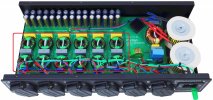If you ever wondered why on sunday mornings (when your neighbor charges his electric car and uses a toaster for breakfast) the speakers sound different - weak bass, noisy.
Here is the explanation:
The first part of this video is correct, but in the middle it becomes an advertising video with dubious explanations and product sales.
The spaces we live in are filled with various electrical and electronic devices. Most of these devices have power control functions such as inverters. When they operate, the power line becomes a waveform that is significantly distorted from the sine wave, causing various problems to devices connected to the same power line.
When the power line waveform is distorted, harmful harmonics such as the 3rd, 5th, 7th, 9th, and 11th harmonics are generated. This causes problems such as whining, buzzing, buzzing, and humming noises in the audio equipment's transformer.
Waveform distortion in power lines caused by harmonics can cause major damage to equipment at power company substations and power receiving substation equipment in cities, sometimes causing fires and explosions. This particularly damages power capacitors for power factor adjustment.
There are various devices that cause distortion in power lines.
Larger items include solar power generation, wind power generation, car charging stations, and power equipment for factories. More familiar items include lighting equipment, air conditioning equipment, washing machines, microwave ovens, induction cookers, and solar panels. All of these have inverters/converters that control the power, which causes the power waveform to be distorted.
In the past, flow angle control using thyristors was often used for power control, which caused large distortions in the power supply line. However, recently the PWM method has been used, and although the interference has decreased compared to before, the incorporation of high frequency noise has become more noticeable.
To improve power line distortion, either stop using the equipment that is causing the problem, or install a device that reduces distortion on the side receiving the fault. In facilities that handle large amounts of power, such as factories, harmonic removal filters and active filters are installed to cancel distortion in the power line.
At home, there is a method of converting alternating current to direct current and then converting it back to pure alternating current. The PS Audio Powerplant P20 introduced in the video is an expensive but perfect choice.
However, the power cord and Puritan Audio PSM156 introduced in the second half of the video have no effect on the problem introduced in the first half and do not solve the problem. I think that the main purpose of the second half is to promote the product, but the introduction of the product is so pointless considering the problems that are occurring.

